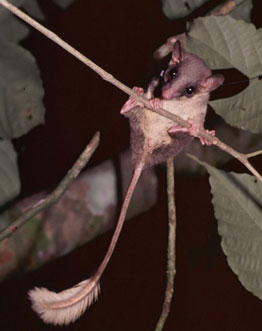Unlike humans, tree shrews don’t get drunk
Heavy-drinking treeshrews don’t get drunk
Jeremy Hance, mongabay.com
July 28, 2008
Although the treeshrew consumes enough alcohol to be inebriated one-in-three nights, the small mammal can hold its liquor better than humans
The pentailed treeshrew, sporting a mouse-like body and feathery tail, seems an unlikely drinker. Yet, new research shows that this one-and-half ounce creature’s main food source, the nectar of the bertam palm, is highly fermented. The nectar can contain a peak alcohol concentration of 3.8 percent. This is a little less than a Bud Light.
The scientists describe the flower buds of bertam palm as a “brewing chamber” with the flowers releasing “a strong alcoholic smell reminiscent of a brewery”. The fermented nectar is available for feeding year-round and is a source of food for more animals than just the pentailed treeshrew — these include the common treeshrew, slow loris, gray tree rat, Malayan rat, chestnut rat, and the plantain squirrel. However, the pentailed treeshrew proved to be the heaviest drinker, spending over two hours a day drinking from the bertam palm. By comparing the amount of nectar drank by species in a twelve hour time period, scientists were able to state that the treeshrew had a 36 percent change of being intoxicated everyday.
 A pentailed treeshrew probing an inflorescence of the bertam palm and licking nectar off flower buds. Courtesy of the National Academy of Sciences, PNAS (2008). |
Despite the high amount of alcohol ingested, the scientists found no visible evidence of deterioration in the behavior of the treeshrew. However, when testing the animal’s hair they found the expected levels of alcohol. The scientists therefore theorize that the pentailed treeshrew has evolved to mitigate the adverse effects of alcohol.
The pentailed treeshrew is believed to be a living relic of treeshrews that lived some 55 million years ago and were probably ancestors of primates. ‘Shrew’ is a misnomer for treeshrews: these small mammals are no longer considered a shrew or an insectivore, but rather a relative to primates and flying lemurs. The pentailed treeshrew is unique among its fellows: it is the world’s only nocturnal treeshrew and is classified in its own family, Ptilocercidae (all other treeshrews are classified in Tupaiidae). The species is not believed to be endangered, although the pentailed treeshrew has not been evaluated for the IUCN red list since 1996 and habitat loss due to palm oil plantations may become an increasingly significant threat.
“Chronic intake of fermented floral nectar by wild treeshrews,” by Frank Wiens, Annette Zitzmann, Marc-Andre Lachance, Michel Yegles, Fritz Pragst, Friedrich M. Wurst, Dietrich von Holst, Saw Leng Guan, and Rainer Spanagel. PNAS Online Early Edition for the week of July 28-August 1, 2008













